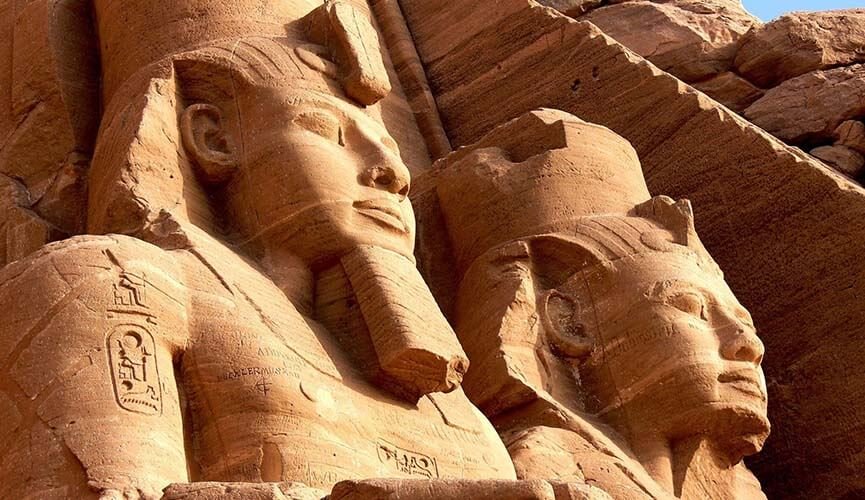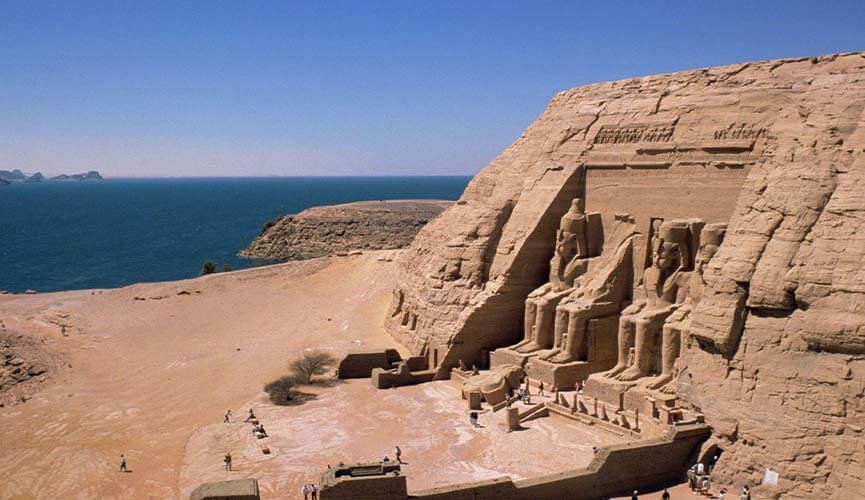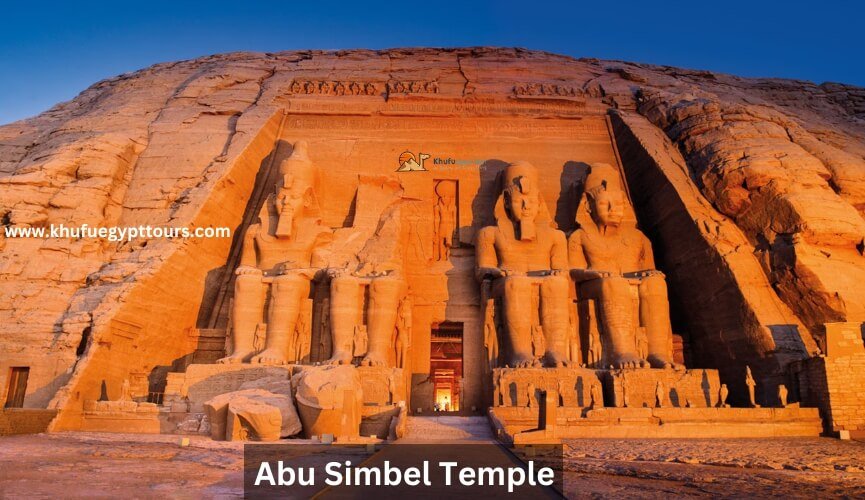Hidden deep in the golden sands of southern Egypt in Aswan City, the Temples of Abu Simbel stand as a breathtaking testament to ancient Egyptian grandeur. Carved into a colossal rock face over 3,000 years ago, these magnificent structures were built by Pharaoh Ramses II to honor himself and his beloved queen, Nefertari.
From the towering statues guarding the entrance to the intricate carvings that narrate epic battles, every detail of the Ramses II Temple Abu Simbel tells a story of power, devotion, and divine legacy.
But beyond their architectural splendor, there’s a fascinating tale of survival—when these ancient wonders faced submersion due to the Aswan High Dam, an extraordinary UNESCO-led relocation project saved them.
Among the many facts about the Abu Simbel Temples Egypt, perhaps the most astonishing is their biannual phenomenon, the Abu Simbel Sun Festival 2025, where sunlight illuminates the inner sanctum in perfect alignment. Want to uncover more Abu Simbel facts? Keep reading to explore the secrets of these awe-inspiring temples!
You can see all the historical places in Egypt through the adventures of the Egypt packages or Day Tours with Khufu Egypt Tours
Key Takeaways:
- Temples of Abu Simbel is a must-visit ancient Egyptian monument.
- Located in southern Egypt, it is a UNESCO World Heritage site.
- Pharaoh Ramses II built the temple complex which features massive statues of the king.
- Abu Simbel offers a fascinating look into Egyptian history, art, and architecture.
- Visitors can explore both the Great Temple and the Small Temple, each with unique features.
- It is a popular stop for travelers to Egypt, especially those exploring Nubia and the Nile Valley.
- The temples were relocated in the 1960s to avoid flooding from Lake Nasser.
- Abu Simbel is renowned for its alignment with the sun during the Abu Simbel Sun Festival.
- Booking a guided tour to Abu Simbel provides an immersive experience and in-depth knowledge.
The Grandeur of Ramses II: History Carved in Stone

The Great Temple of Abu Simbel, often referred to as the “Temple of Ramses II,” was constructed to honor the king and his divine status. The temple is known for its colossal statues of Ramses II, each standing 20 meters tall, which dominate the entrance. These statues are not merely decorative; they serve to showcase the king’s power and his connection to the gods. Carved directly into the mountainside, the structure itself is a magnificent feat of engineering and artistry.
Inside the temple, visitors are greeted with magnificent halls, statues, and reliefs that depict Ramses II’s victories and divine right to rule. The most famous reliefs portray Ramses II at the Battle of Kadesh, a pivotal moment in Egyptian history. These impressive images offer travelers a visual journey into the ancient world, showcasing Egypt’s military prowess, religious beliefs, and artistic heritage.
The Small Temple: A Tribute to Nefertari
Less well-known than the Great Temple, the Small Temple of Abu Simbel is a hidden gem that also demands attention. This smaller structure was built to honor Ramses II’s favorite wife, Nefertari, and the goddess Hathor. The temple’s exterior features six statues, four of which depict Ramses II, and two of Nefertari, highlighting the queen’s importance. Inside, the temple is decorated with beautiful reliefs showing Ramses and Nefertari performing rituals before various gods, a testament to their divine partnership.
Though smaller in size, the Small Temple is no less impressive. Its intricate design and historical significance make it an essential part of the Abu Simbel experience
Relocation of Temples of Abu Simbel: Saving from the Nile’s Rise
One of the most remarkable aspects of the Abu Simbel Temple is its relocation. In the 1960s, the construction of the Aswan High Dam and the creation of Lake Nasser threatened to submerge the temples. In a massive international effort, the temples were carefully dismantled, block by block, and moved to a higher location. This monumental task required the ingenuity of archaeologists, engineers, and artisans, who worked together to ensure the temples’ preservation for future generations.
Today, visitors can see the incredible skill that went into relocating the temples, as the structures were carefully reassembled at their new site, some 200 meters above the original location. This preservation effort not only saved the temples from flooding but also ensured that future travelers could experience one of Egypt’s greatest treasures.
The Abu Simbel Sun Festival: A Phenomenon of Ancient Engineering
One of the most awe-inspiring features of the Abu Simbel Temple is its alignment with the sun during the Abu Simbel Sun Festival. Twice a year, on February 22 and October 22, the sun’s rays penetrate deep into the inner sanctum of the Great Temple, illuminating the statues of Ramses II and the gods sitting alongside him. However, the rays do not illuminate the statue of Ptah, the god of darkness, which is believed to symbolize the triumph of light over darkness.
This spectacular event is a marvel of ancient engineering, as the temple was meticulously designed to align with the sun’s movements. The precision with which the ancient Egyptians achieved this alignment is a testament to their astronomical knowledge and understanding of the natural world.
Visitors who are lucky enough to witness the Sun Festival are treated to a rare and magical experience, where ancient rituals and modern tourism converge.
Why Visit Abu Simbel: A Cultural and Historical Experience

Abu Simbel is not just a visit to another ancient monument; it is a journey through time. The temples offer a glimpse into Egypt’s ancient history, from the reign of Ramses II to the engineering feats of the 1960s that saved them from the rising waters of Lake Nasser.
For travelers interested in Egyptology, Abu Simbel offers an immersive experience. The temples provide a deep dive into ancient Egyptian religious practices, royal life, and military conquests. Whether you’re admiring the giant statues or exploring the intricate reliefs, Abu Simbel gives you a unique perspective on Egyptian civilization.
In addition to its historical value, Abu Simbel offers a serene and awe-inspiring setting. The vast desert landscape and the stunning views of the temples create an atmosphere of tranquility, making it a perfect place for reflection and photography. The isolation of the site, away from the bustling cities of Egypt, adds to its mystique and charm.
How to Get to Abu Simbel: Travel Tips and Options
Visiting Abu Simbel is an unforgettable experience, but getting there requires a bit of planning. Located approximately 280 kilometers south of Aswan, Abu Simbel is accessible by road, air, or boat. Here are your travel options:
- By Plane: The quickest way to reach Abu Simbel is by taking a domestic flight from Cairo or Aswan. The Abu Simbel Airport is just a short distance from the temples, making it an easy option for time-conscious travelers.
- By Road: For those seeking a more scenic and adventurous route, driving from Aswan to Abu Simbel is a popular choice. The journey takes about 3 to 4 hours, and visitors can enjoy stunning views of the desert landscape along the way.
- By Boat: You can also reach Abu Simbel by boat, traveling down the Nile River. This option offers a more leisurely experience, allowing you to take in the sights of the river and surrounding areas as you approach the temples.
Conclusion: Temples of Abu Simbel
The Temples of Abu Simbel are more than just ancient monuments—they are a remarkable symbol of Egypt’s rich history, architectural brilliance, and cultural legacy. From the awe-inspiring Temple of Ramses II Abu Simbel Egypt to the fascinating Abu Simbel Sun Festival, these temples continue to captivate travelers from around the world.
Whether you visit for their historical significance, stunning artistry, or the magical solar alignment, the Abu Simbel Temples Egypt offers an unforgettable journey through time.

